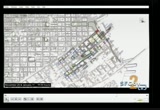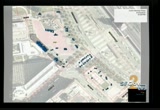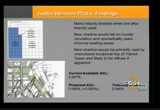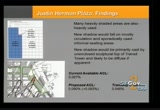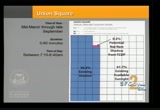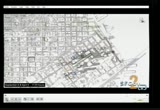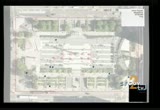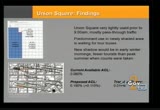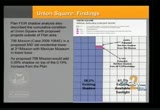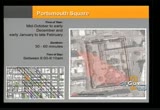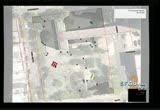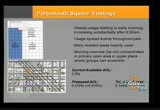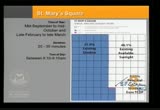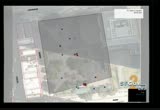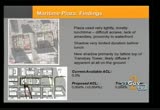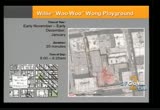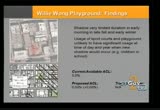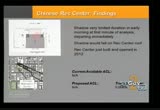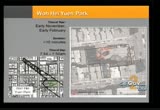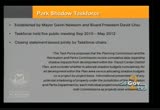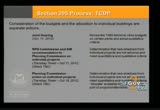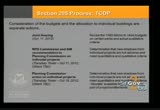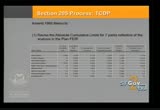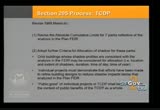tv [untitled] October 3, 2012 1:00am-1:30am PDT
1:00 am
plaza and portsmouth. i will show you one more time and pause it. here the shadows are moving fast in the morning. between 10:00 and 11:00 they slow down and start moving very slowly through the midday hours. here is 1:00 in the afternoon. 1300 hours. none of the buildings have yet hit justin hermann plaza. you can see -- you can identify the transit tower a bit. it is the longest one in the middle. you can see the architectural top rendered on there. this is roughly the time that the maximum shadow would fall on justin hermann plaza, so you can see it is the top of the
1:01 am
hermann plaza and falls on a portion of the sunken plaza and a bit on the market street extension. this park, as i mentioned, is shadowed by a couple different buildings, so this potential max mm 50 minute time is not consistent. it is a few minutes from the transit center, i will let it play. almost an hour goes by. another building goes by roughly over the market street extension area, where the market is where people pass back and forth through the ferry building. then by 3:00 it is totally gone. we can come back and show the videos during question and answer but i will move on back. so one other thing we did for four of the major open
1:02 am
spaces was to actually go out this summer and actually do some usage observations of how many people were using the park at these hours, where they were in the park, what they were doing so if we can see if there are conclusions that can be drawn in terms of analysis of the different parks. so what these show -- you can see this is an aerial of justin herman plaza. each letter is a person. all the blue ss, that stands for standing or stationary or seated. someone is doing something where they are staying still. green p is where kids are playing. e is exercising. you don't find that in justin hermann plaza but might in others. i will flip through these. this is a half hour slice through the middle of the day starting at noon and going through 3:00 p.m. generally, by and large,
1:03 am
justin hermann plaza is used almost heavily at the edges along the edge of the hotel that has the fixed seating and restaurants. you can see large concentration there is and around the perimeter. another thing -- we noted where there was sun and shine in the plaza at these times so we would maybe see if there were finding drawn from that as well. the shaded areas are sort of outlined in darker gray. in this image it is up against the hotel on the west side of the plaza, where you actually do see a concentration of people in the shaded areas. people spread throughout the mark. generally the heaviest are in the shaded areas up against the building. move to 1:00. very heavy concentration of people in the shaded area against the building where the seating is. some other people around the park. 1:30. the heaviest is up against
1:04 am
the hotel. then 2:30 similar conditions. after 2:30 we can find the usage of the park was down substantially. well past people's extended lunch hours, the park is most heavily used between noon and 2:00. by 2:00 it is largely emptied out except for people passing back and forth to the ferry building. what conclusions could you draw? these are mostly observations. many of the shaded parts are some of the heaviest uses of the plaza. in terms of the shadow it does mostly fall on portions of the plaza that aren't extremely heavily used, the sunken portion of the plaza. some of circulation areas adjacent to market. the time for the shadow is cast by the structural lattice top of the transbay
1:05 am
tower. based on our consideration we think that is probably likely to be diffused. if you notice that shadow once it is built. in terms of numbers there is currently quote unquote budget available for justin hermann plaza,.007% of theoretical annual sunlight. the plan cumulatively, all the buildings together could potentially ad.09%. i said.1. that was rounded up. it is.09 or less. you can see the difference in.09 and.007 is.083. that would be the proposed increase for just ten hermann plaza. we noded how much individually the transbay tower, since this is coming to you shortly. what that would account for of the total plan. it is about half and total
1:06 am
of potential shadow, 0.46%. moving on to union square, union square, most of that could potentially be shaded by five buildings in the area. most of which are 2500 to over 3,000 feet away. one project potentially about 1,500 feet away. total about.2% of additional shadow could be added to the 38.3% shading that exists today. generally mid-spring through sort of end of summer is when the new shadow could potentially fall. ranges from five minutes to maximum 60 minutes, all before 9 a.m., between a span of 7:00 to quarter to 9:00. where the shadow would fall, again sweep across the park. at the time there is a maximum new shadow on union square. permanently you can see it fall on the southern edge of the square, the sort of
1:07 am
terrace area that leads down to yurie street. let me just jump to the video. let me just back it up. these are days when shadows from the plan hit union square. i will stop it right here. this is some time between 8:00 and 9:00. you can see there is some additional shadow again as shown in the previous graphic on the southern edge. little at the center of the cart. sweeps across the park by basically by nine. actually before 9:00 it is
1:08 am
gone. rest of the day continues on as it typically is. here is our usage analysis of union square, which is interesting. we noted the weather at the time. we did these at the height of summer. not surprisingly it was a foggy day. for most of the morning there was no discernible sun or shade. it was shrouded by clouds. we started at 7 a.m. got there bright and early. there are very few people who use union square at these hours. we have the figures available for the subsequent hearing comparing the number of people passing through, versus the number of people stationary through the square. until you get to 8:30 or 9:00, there's more people
1:09 am
walking through the square than actually sitting in the square doing something. there is less than ten people in the square at 7 a.m. 7:30 there's about 15 or so. most are concentrated in the southwest corner on the terrace steps. our observation noted those were tourists waiting for the tour buses that pick up passengers at that corner. so they were reasons to pick up the bus. that is why they were there. not necessarily because they wanted to sit in that part of the park. 8:00, not more than 20 doing things in the park. still roughly 20 people spread throughout the park. by 9:00 you start to get a lot more people in the park. 9:00 is roughly the time all the movable chairs are put out in the park. before that all the seating is whatever you see in the park. you can start to see at
1:10 am
9:00 more people in the center of the square and dispersed throughout. so 9:00 is when activity starts picking up. here is 9:30. you can see between 9:00 and 9:30 the usage of the park. so as i mentioned our observation is union square is lightly used before 9 a.m. this is the summer, height of the tourist season when you probably find the most people using the square. the predominant use in the area that would be most heavily shaded are people generally waiting for the tour buses. and as i mentioned most of the -- we will just move on to the numbers. excuse me. there is currently budget available for union square. .08%. in total all the plan
1:11 am
buildings together would ad.19, so the different is.11%. transbay is 10% of that, 0.11%. one other note, the eir for the plan did look besides just the plan buildings what other projects have been filed that are out that might also potentially shade union square, to give a full, cumulative look at what is coming. there is one project on file. 706 mission, the mexico kal museum tower project. that also outside of this area not really subject to liberations on this plan. in itself would add 0.9% in union square, in addition to what this plan would add. that is just to provide
1:12 am
context. * portsmouth square, moving on to three buildings that might potentially shade it. portsmouth square, the new shadow would fall * in the late fall, then later on in the winter. also generally before 9 a.m. between 8:00 and 9:00 and between 30 and 60 minutes. as you can see in the graphic the moment the maximum extent of shadow would be the southwestern half of the square. you know, it falls on some of the open areas and playground areas in the southwestern part of the park. and i will just move on to the usage analysis and maybe show the -- we can go back the video later if you'd like. so this -- we actually got out there before 8 a.m. unfortunately we don't have a graphic. there are more people in
1:13 am
portsmouth square before 8 a.m. than between 8 a.m. and 9 a.m. that was before the sun came up. the sun came up for roughly a little after 8:00. you can see it was sunny day so there were parts in the sun already and some that were shaded. the little red es are people exercising, generally doing t'ai chi, adults. these are kids in the playground and people sitting around different parts of the park. there are roughly 20, 25 people in the park. moving on to 9 a.m., a few more people spread throughout the park. by 9:30 the usage takes off, more than doubles. then 10:00, similar. anywhere you see 10:00 is
1:14 am
the heaviest concentration. so portsmouth square, heavy use. it starts before the sun comes up and takes off after 9:00. it is spread pretty evenly throughout the park. we can go back to the image, if you'd like. there are heavily shaded parks heavily used because the park is so generally impacted by usage that people tend to look wherever they can find space to sit and congregate, regardless of whether it is sunny or shady. the morning t'ai chi exercises, which we saw in the map, are generally in the open area because that is the only open area where a group can congregate to do that type of activity. there is a budget of zero for portsmouth square.
1:15 am
the buildings would potentially add.41% to park, which the transbay power is.113%. same area square, similar distance. this shadow would happen same as portsmouth. late, mid fall. then late winter. from at most 20 to 30 minutes. again, a similar time of day. maximum amount.09%. here you can see generally where the shadow would fall on st. mary's square, the southern corridor, if you will, adjacent to pine street. that area there are kind of open seating areas, planters and you can see a lot of circulation leading to and from. here is our analysis of st.
1:16 am
mary's square. it is a fairly heavily shaded square. it is on the edge of financial district and across the street from a very tall building. if at 8:30 a.m. it is in shade when we were there. there were about 20 in the park. we found this constant throughout the morning. not really were there ever more than 20. about half were doing t'ai chi in different areas of the park. you can see fewer people at 9:00. then you see fewer at 9:30 when there is more sun in the park. then 10:00 roughly about the same condition. same area much slightly more used than the other open spaces. a fairly steady uses. the red is where people seek parts of the park where they can have their
1:17 am
own space. that is sort of what we found to be the case, like sun or shade. like portsmouth, st. maries has a zero cumulative limit. the total potential shadow from the plan would be.09%, of which the transbay tower would be about half. moving on to the other parks and with the much shaded significantly less than other parks than we also can the usage analysis in observing each of these parks, simply because they are not as heavily used and at least the observations were gained easily otherwise. maritime park, about 2,000 feet from the one building. transbay tower, which might shadow it. the maximum duration, duration at all would be
1:18 am
about 25 minutes, between 10:40 and 11:05, the narrow sliver on the western portion of the park. plaza where the transbay lines up with the slice between two of the embarkadero buildings. our observations regarding maritime plaza, it is a very slightly used in general. most is from office workers immediately ai jay september. even that it is partly used. one, it is very difficult to access. it is elevated. because it is elevated there are a few not very visible ways to get to the park. lack of amenities there, is not much other than seating. it is adjacent to the waterfront so people have more expensive and other spaces to use so they don't
1:19 am
use maritime much. the shadow is limited in duration. again, this shadow like some of the others is cast almost exclusively by the latticed top of the transbay tower. the total would be.004% of annual sunlight and park has zero tolerance. the willie wong playground, another china town open space, shadowed by two buildings in plan area that are about 3,000 feet away. the shadow would fall generally in the late fall. very early winter. maximum extend would be 20 minutes. between 8:00 and 8:25. it is limited. it is fast and swift and doesn't happen for long. it would generally fall on the southern part of the playground on part of the
1:20 am
playground and sport adjacent to the adjacent street. our analysis is at this time of day, this time of year between 8 a.m. and 9 a.m., children, primary users, are in school. not likely to be on the playground at 8 a.m. on a november day. transbay shower does not shadow this park but potentially other buildings by about.03%. chinese reck center is another potential of the parks. almost a full mile away from the one building. the transbay tower. the shade would happen in mid october and february for one or two weeks at a time. shadow would be a maximum of five minutes long. at 8:25 a.m. in five minutes is maybe a generous total for that but
1:21 am
it does potentially hit it. most the shadow would fall on the roof of the new reck center building. the reck center was just built. opened this year. we believe the shadow, five minutes a couple weeks the year and falls mostly on the roof of the reck center would almost not be visible to anyone. there is no budget established. you would need make finding about adversity or lack thereof to this open space. for quantitative purposes the transbay tower would add.008% shade to reck center. lastly bowdecker park, about a mile away from the one building, the transbay tower, which might shade it. this would happen in early
1:22 am
summer. like the reck center, five minutes, less than a month a year before 7 a.m. the shadow would fall on the edges of the park along the ellis street edge and the young street edge. there is -- bodecker park is slated to be completely renovated in the next few years there is a project for public land to fund and rebuild this park. so the analysis is based on the approved plan the commission has approved for the renovation of this park. where does this analysis on this park -- there was a limited five-minute analysis for a few weeks a year. it would fall on the street
1:23 am
edges, plantings but not public access and service gate. interestsingly the one before 7 a.m. at this park has not been historically opened during the last many years. it is only generally open in the middle of the day. the total cumulative shadow from the plan, which is only from the transbay tower would be.003%. there is one more. the park on the northern edge of china town. this also is a park where the shadow would be limited in duration, less than ten minutes. for a week or two in early november and a week or so in early february. also before 8 a.m. for about a six-minute slice, before 8 a.m. the potential shadow would hit the northern street edge of the park, where there is an arbor and picnic tables and a small bit to the western part of the park. the shadow would mostly occur on edges that
1:24 am
represent the main central gathering areas for people who might be there for t'ai chi might be. .011% and only by the transbay tower. moving on to the general consideration for actions that you might take at the joint hearing in the future, there was committee established by then mayor newssom and board member chu regarding section 295. that task force held several meetings over the course of a year and a half. * and this past may the joint chairs, one appointed by the mayor and other by president david chu, issued a closing statement that said this. i will just read it. the task force proposes the planning commission and recreation and parks commission review cumulative data regarding shadow impacts from development within the
1:25 am
shadow district land and consider whether to allocate budgets cumulatively for all development within the plan area versus allocating on a project-by-project basis. informational presentations under the jurisdiction of reck park department, but each would be made available to commissions as project seems entitlements. this sort of speaks to sort of the two-step nature of actions related to section 295, where we are talking about parks with shadow budgets. generally the action to raise or consider raising a shadow budget is a different action than the commission, the commissions would take to determine the adversity or lack throughout of impacts from any particular building. so it takes a joint action of the commissions to amend the 1989 memo and change any of those budgets or any of the criteria or discussion.
1:26 am
the commissions act separately when considering individual shadows from individual buildings. as such there is a joint hearing for two weeks from now for you to consider with the reck park commission sort of cumulatively or not. changing and budgets for one or more of these parks. on that same day provided there is action to at least change the budgets for the transbay tower. the reck park would consider that project and consider that a week later on october 18th. this generally would be the process for future buildings before you. the department feels as you read in the staff report for today and again for two weeks from now based on the shadow task force recommendation as well as our conceptions of district plan would has been adopted that we feel that the most
1:27 am
prudent course is change budget for the entire plan. as each project comes in you assess, as typically happens, the adversity of typical projects. this we think important for a number of reasons. when the 1989 memo, sort of an action taken at the discretion of two commissions. it was done based on deliberation of the lay of the land at that time. open space system. sort of the downtown plan where there was development anticipated. lack of open space on the south of market and so forth. we are now -- so that was sort of a cumulative, comprehensive action. to date pretty much almost every time and not exclusively but most of the times the budgets have been changed. then sort of because individual projects that have come up that have warranted some consideration based on single projects alone.
1:28 am
this is the first time since the memo we have had any sort of comprehensive rethinking of the downtown landscape. not just development but the open space landscape. so based on the new information and new plans, we think it is prudent to revise the memo in a comprehensive manner in recognition of the plan that the city just adopted. so with that the department proposals in two weeks, on the 11th, the two commissions amend the 1989 memo to revise the absolute cumulative limits for the seven parks that has them that could potentially be shaded by buildings in plan area and be reflective of what was in the planned eir. additionally, the department also recommends
1:29 am
that qualitative material be adopted. not just numerics because clearly the number doesn't show you the whole story but where the shadow would fall and how long it would last at any one time. like done for three parks given budgets or greater than 1989 we recommend commissions also adopt essentially criteria that any new shadows that would be considered within these new increased budgets would be consistent with shadow profiles analyzed in the plan's eir. so if a building came along that wanted to shade union square that wasn't -- or portsmouth square that wasn't consistent with shadow profile analyzed in this planned eir but states within the budget, it wouldn't meet the qualitative criteria. secondly the commission hold projects to higher st
128 Views
IN COLLECTIONS
SFGTV2: San Francisco Government Television Television Archive
Television Archive  Television Archive News Search Service
Television Archive News Search Service 
Uploaded by TV Archive on

 Live Music Archive
Live Music Archive Librivox Free Audio
Librivox Free Audio Metropolitan Museum
Metropolitan Museum Cleveland Museum of Art
Cleveland Museum of Art Internet Arcade
Internet Arcade Console Living Room
Console Living Room Books to Borrow
Books to Borrow Open Library
Open Library TV News
TV News Understanding 9/11
Understanding 9/11
